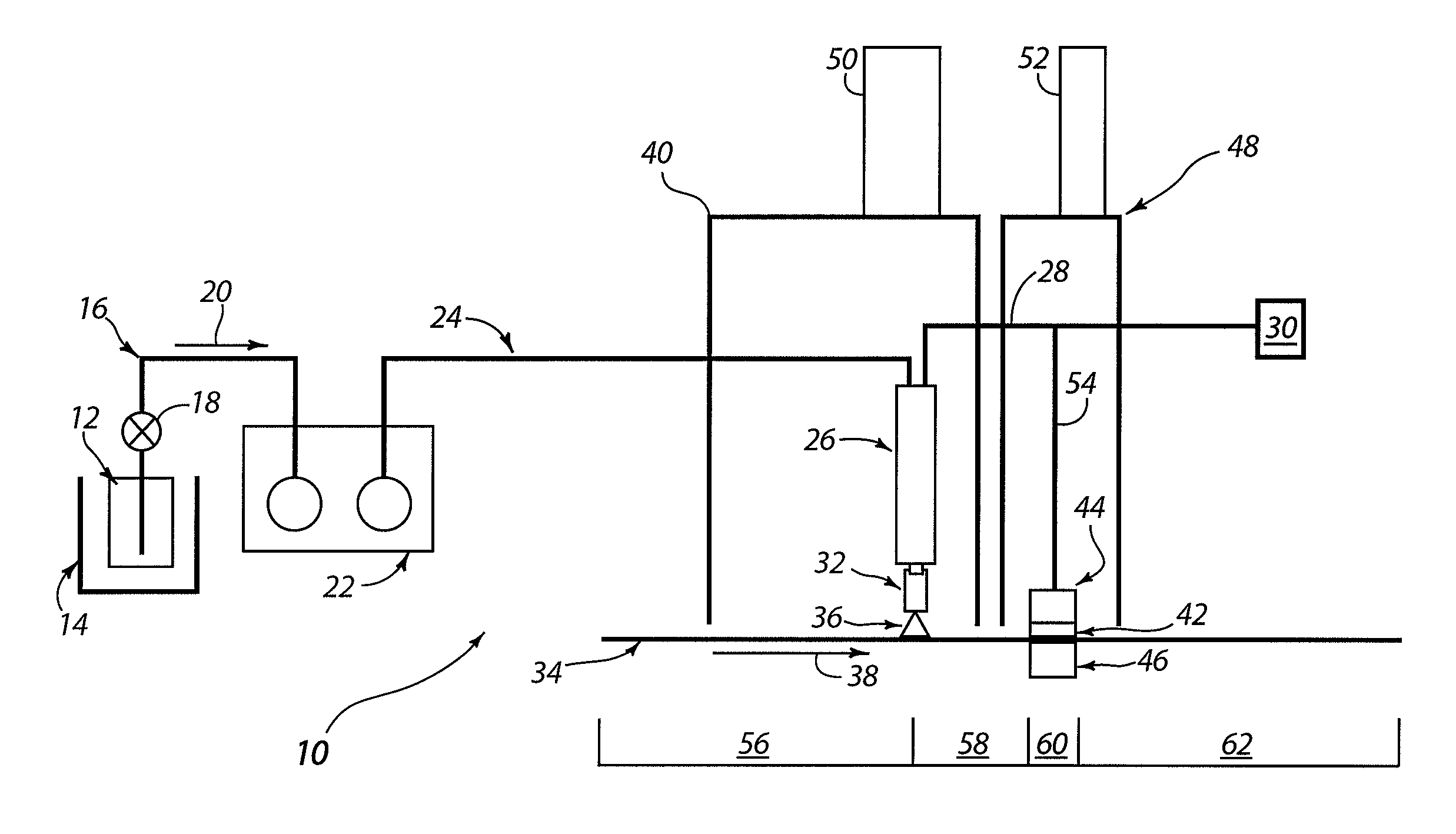Treatment of fibrous materials using atmospheric pressure plasma polymerization
- Summary
- Abstract
- Description
- Claims
- Application Information
AI Technical Summary
Benefits of technology
Problems solved by technology
Method used
Image
Examples
example 1
[0064]FIG. 4 is a graph of 3M Test Score for hydrophobicity as a function of the number of wash and dry laundry cycles for 100% woven polyester (Mt. Vernon) fabric, plasma dry-treated for hydrophobicity using the apparatus shown in FIG. 1, with the following conditions: Zonyl® TA-N liquid feed of 0.4 ml / min, at a of 65° C., and an evaporator temperature of 175° C.; applicator temperature of 175° C.; web speed of 1.5 m / min; radio frequency power of 1.55 W / cm2 at 13.56 MHz; and helium process gas. The electrode area used to generate the plasma was 33 cm×1.25 cm, the gap between the applicator and the fabric was 0.254 cm, and the gap between the fabric and the opposing rf electrode was 0.160 cm. This corresponds to a polymerization time inside the plasma of 0.5 s. Correspondingly, a 1 m width of plasma in the direction of the web travel requiring 0.5 s for polymerization would permit a maximum line speed of 120 m / min. The polyester fabric was initially at room temperature, with no pre-...
example 2
[0065]FIG. 5 is a graph of the 3M Test Score for hydrophobicity as a function of the number of dry cleanings for woven silk fabric (Dupioni), treated for hydrophobicity using the apparatus shown in FIG. 1. The silk was treated using the same process conditions used for the polyester treatment in EXAMPLE 1, hereof, except that only 4 sequential passes were made, and the durability results were obtained from a commercial dry-cleaning establishment. No boost agent was used in this example. The numbers above the bars in FIG. 5 indicate the results for two different samples treated.
example 3
[0066]FIG. 6 is a graph of the 3M Test Scores for both water and oil repellency as a function of composition of monomer feed gas for furniture upholstery fabric (Sunbury Mills) treated for hydrophobicity using the apparatus shown in FIG. 1 hereof. Three compositions were applied: (1) only telomer chemistry (Zonyl® TA-N); (2) telomer chemistry plus 10% (by weight) of added methyl anthranilate; and (3) telomer chemistry plus 20% (by weight) of added methyl anthranilate. The “boost” effect for both water and oil repellency on the final result, is readily observed. Process conditions were as follows: Zonyl® TA-N was introduced at 0.4 ml / min, with a liquid feed temperature of 65° C., an evaporator temperature of 170° C., and an applicator temperature of 180° C.; the applied radiofrequency power was 1.55 W / cm2 at 13.56 MHz; and the process gas was helium. The electrode area used to generate the plasma was 33 cm×1.25 cm, the gap between the evaporator and the fabric was 0.254 cm, and the g...
PUM
| Property | Measurement | Unit |
|---|---|---|
| Frequency | aaaaa | aaaaa |
| Frequency | aaaaa | aaaaa |
| Pressure | aaaaa | aaaaa |
Abstract
Description
Claims
Application Information
 Login to View More
Login to View More - R&D
- Intellectual Property
- Life Sciences
- Materials
- Tech Scout
- Unparalleled Data Quality
- Higher Quality Content
- 60% Fewer Hallucinations
Browse by: Latest US Patents, China's latest patents, Technical Efficacy Thesaurus, Application Domain, Technology Topic, Popular Technical Reports.
© 2025 PatSnap. All rights reserved.Legal|Privacy policy|Modern Slavery Act Transparency Statement|Sitemap|About US| Contact US: help@patsnap.com



